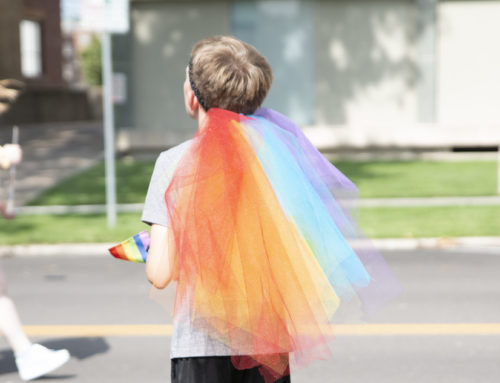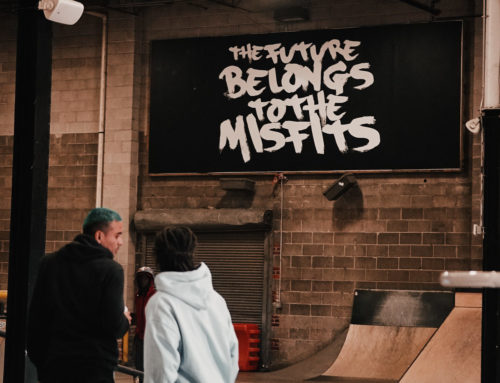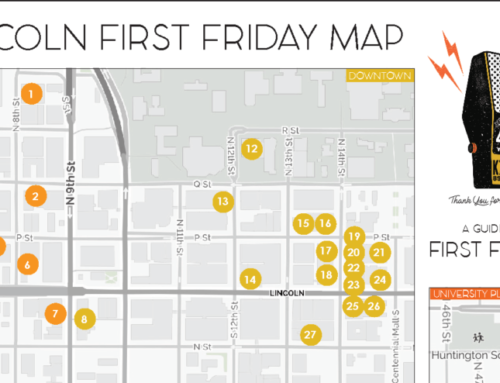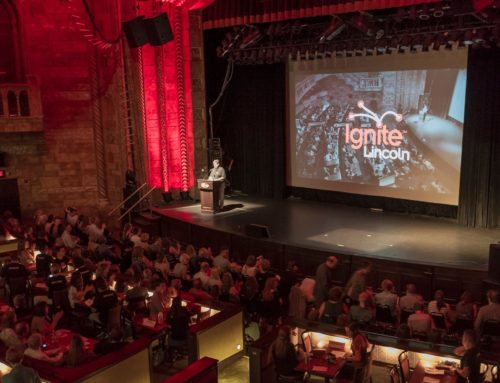By Hannah Rivers
Nov. 16, 2016
On the day of the election, after voting of course, I chose to give attention to something more soothing — art. With the drama of politics threatening to suffocate the country, I decided to learn more about an artist and her creative process. To talk about inspiration and nudity and milkshakes. It was nice for a change to discuss how someone expresses their soul, as opposed to how they express their political leanings. Although politics was not completely absent from the conversation, the focus was elsewhere. It was on bigger things: art and life and people and feeling.
Josie Karre is a Lincoln-based artist in her mid-20s who not only makes art, but also displays it as well. Karre is the owner of Blueberry Center Gallery, located in Parrish Studios that sits right above Ali Baba’s on 14th street. Add in a table, a chair and some art supplies and the gallery becomes Karre’s personal art studio.
I was surprised when I first saw her; for some reason I had expected something completely different than the dark-haired woman with purple glasses that met me at the door. My vision of Karre had been that of the prototypical artist type: an eclectically-dressed, wild-haired woman in her mid-40s. But she looks like a normal person, only way cooler. It just so happens that she paints pictures featuring nude figures and food.
With those two things being the main focus of her current series, it makes sense that the title of Karre’s exhibit is “Favorite Foods and Better Outfits.” This accurately describes what you see when you look at one of her paintings. All three of the pieces that are hanging in her gallery show a naked person (two women and one man respectively) eating some kind of food (watermelon, an ice cream cone, a burrito).
The name came about out of humor; Karre just thought it was a funny title. Since all of the human subjects aren’t wearing any clothes, it can be assumed that the best outfit of all is your birthday suit.
The name of the gallery originated in a similarly seamless manner, popping into Karre’s head after she painted the room blue. But that was the easy part. The process of deciding which color to use was a bit lengthier.
“I figured if I painted it white it would just look like every other gallery up here,” said Karre.
And so she chose a hue that was unique, but still neutral. The pale blue covers all four walls, while the floor is a darker shade. Most of the decor is blue, too—making Blueberry Center Gallery the perfect name. As if there wasn’t enough blue, each painting features the color. In the one with the woman and the watermelon, there is a blue sky. In the other two there are blue accents, which is due to the fact that both were painted from pictures that Karre took in the gallery.
That is how she paints all of her pieces in fact. She gets a volunteer to pose for her, takes a photograph of it and then works from the photograph to make a painting. The reason that Karre does this is mostly out of convenience. This way her subjects don’t have to be naked for a whole month while she tries to paint them. Employing the Blueberry Center Gallery as her prominent shooting location is also a conscious decision that stems from ease of use. Where else are you going to photograph people while they’re naked?
It was nudity (and also pie) that was responsible for inspiring the series “Favorite Foods and Better Outfits.” Earlier in the year Karre did a painting of a naked woman shoving pie in her face.
“I did that as a kind of jab at the whole Photoshop culture,” Karre said.
The piece was meant to expose all of our flaws as human beings. It was an emotional way for Karre to express herself through the act of a woman shoving pie in her face — with mascara running down her face and a baked good spread all over her countenance. The inspiration for the piece involved Karre contemplating how people think they should look, how they actually look and how they shame themselves for what they eat. The Photoshopped models that are widespread in all forms of media have been altered in a way that the finished product doesn’t even look like them. All of this led to Karre’s pairing of food and nudity.
When she painted the piece with the girl and the watermelon, the theme switched to one of consent.
“Although she’s nude, it doesn’t give you consent to sexualize it,” Karre said. “Even though you may be sexually attracted to the image itself. It’s not meant to be sexual in nature, which is kind of asking a lot of my audience.”
Another one of her paintings features a naked man eating a burrito, which is something that Karre sees as being in the same category as the woman with the watermelon. Though not everyone thinks they’re the same thing.
“I feel people revolt against that painting more,” said Karre. “Just because it’s male.”
One example is her parents. They hate the painting because the man’s private parts are in the center of it. They asked their daughter what she’s trying to say with that decision.
“I’m just saying that you can look at her boobs all day,” she said. “But the second you look at his d*** you’re all offended. I felt like he had a place in this showcase.”
Part of the reason that Karre wanted that piece included in the series was so she could use it as a kind of filter. It was placed on the wall opposite the door so that people would see it from the hallway and either want to come in or avoid the room altogether. This ensures that the people who are interested in the art can look at it without being interrupted by the immaturity of others who can’t handle the nudity. And these are precisely the kind of people Karre wants her work to attract: the people that want to see it.
“I figure if they can’t handle him and his maleness, then they don’t get to come and see the ladies.”
While there were some people of an older generation that were repelled by the nudity, they were in the minority. Most, like the human subjects Karre uses in her paintings, embrace it. The three people that are featured in the pieces that currently hang in the Blueberry Center Gallery are coworkers of the artist who willingly posed for her. They all work at Live Yes Studios, which supports adults with developmental disabilities by teaching them art. Some were asked by Karre to be a model (no one has said no so far), but others volunteered for it. Now that she’s done more paintings, Karre finds that people will come up to her and ask if they can pose. But she doesn’t think it’s weird that there are so many people who are willing to pose nude.
“You wouldn’t think so, but they’re all out there, and I work with most of them,” she said.
Karre’s work at Live Yes Studios is not the only way she’s involved with the community. She is also a part of the Lincoln art scene, which is known for being a supportive and inclusive group of people.
“It’s pretty casual and pretty open to anyone that wants to participate in it.”
From drawing during her childhood to graduating from UNL with a Bachelor of Fine Arts to owning her own gallery, Karre has come a long way. After high school, everyone asked her what she was going to do. She realized that there wasn’t ever any other option in her mind besides being an artist. As for how she got the Blueberry Center Gallery, her husband gave it to her as a wedding gift. So now every First Friday there is a show in there — either Karre’s pieces or one of her artist friends’.
Although Karre didn’t sell anything, she thinks November’s First Friday went well because she got to have a lot of great conversations.
“I got to talk to a lot of people about what I’m trying to say with my art, which is good because not everybody’s usually interested enough to ask what you’re trying to say,” she said.
Three of her paintings are currently hanging in the Blueberry Center Gallery, but they won’t be there for long. Sometime before next month’s First Friday a few of her friends will put up their art for a group show. But until then people are free to come by and check out Karre’s pieces.
As for what she hopes they take away from the experience, Karre wants viewers to at the very least appreciate her work on an aesthetic level. She thinks a lot about her compositions, her colors and her use of positive and negative space. But she also wants people to think about context. Instead of asking themselves why there’s a woman eating watermelon in a field, Karre urges viewers to dig a little deeper—to be cognizant of the fact that there are a lot of women’s issues in pop culture. She wants people to make the connection.
“I don’t know if that’s always reasonable to ask, but I like to think people will get there on their own,” she said.
She also wants viewers to make connections with how the paintings relate to one another. Since she does her paintings in series, they all build off of each other. Karre isn’t sure if people will make these connections, but even if they only appreciate her work for its aesthetic appeal, she’s happy they came to see it at all.
Karre used to draw from imaginary characters in high school, but once she got to college and took art history classes, she started to build off of the work of other artists using her own style.
“You’re constantly trying to be unique, but everybody’s pretty much done everything,” said Karre. “You might as well just do what you want to without worrying about how you’re doing it or who’s done something similar.”
With all the amazing work people have already done, there’s no need to reinvent the wheel.
“I think the battle of trying to find something completely unique is a losing one.”
Another thing that’s changed throughout her life is the amount of frustration involved in the making of her art. Karre used to get very frustrated, but now that she has gotten used to her own artistic process, there is much less kicking and screaming. She still struggles, but she has accepted the fact that everything has what she calls an ugly phase. Some last longer than others, but Karre has learned that you just have to keep working until you see the light at the end of the tunnel.
“If you’re working on something, just keep working on it,” she said. “You figure something out. You print off a better picture, take a break and come back to it and maybe it’s not as bad as what you thought it was when you left it.”
Karre and I talked a lot about her art, about what inspires her and what her process is like, but the end of the interview was reserved for questions of an extraneous nature. To find out more about Karre as a person, I asked her about her favorite things.
Her favorite decade of music is the present one, specifically bands like The Black Keys and the Arctic Monkeys. Her favorite restaurant is Honest Abe’s, which may or may not have something to do with the fact that it’s a block away from her studio. Karre prefers summer over winter and the morning to the evening.
“I’m a morning person,” she said. “I don’t wanna be. I’d rather say I was a night owl. I do go out, but I wake up, drink a couple cups of coffee and I’m ready to go.”
If she were an animal, Karre would be a housedog because then she could be cute constantly and do nothing all day. She couldn’t tell me what the funniest thing that happened to her recently was, but she did tell me a story about waking up covered in hives. If Karre could travel to any country in the world, she would choose Belize. As for Europe, she’s interested in Venice, Italy, because of the glass blowing there.
Whether it’s blowing glass or painting nudes, she’s definitely following her dream.
“I want to make art,” Karre said.
And that’s all she needs to know.
For more information on Josie Karre, check her out on Facebook or Instagram.
Hannah Rivers and Cameron O’Brien are two of KZUM’s tireless fall interns.
